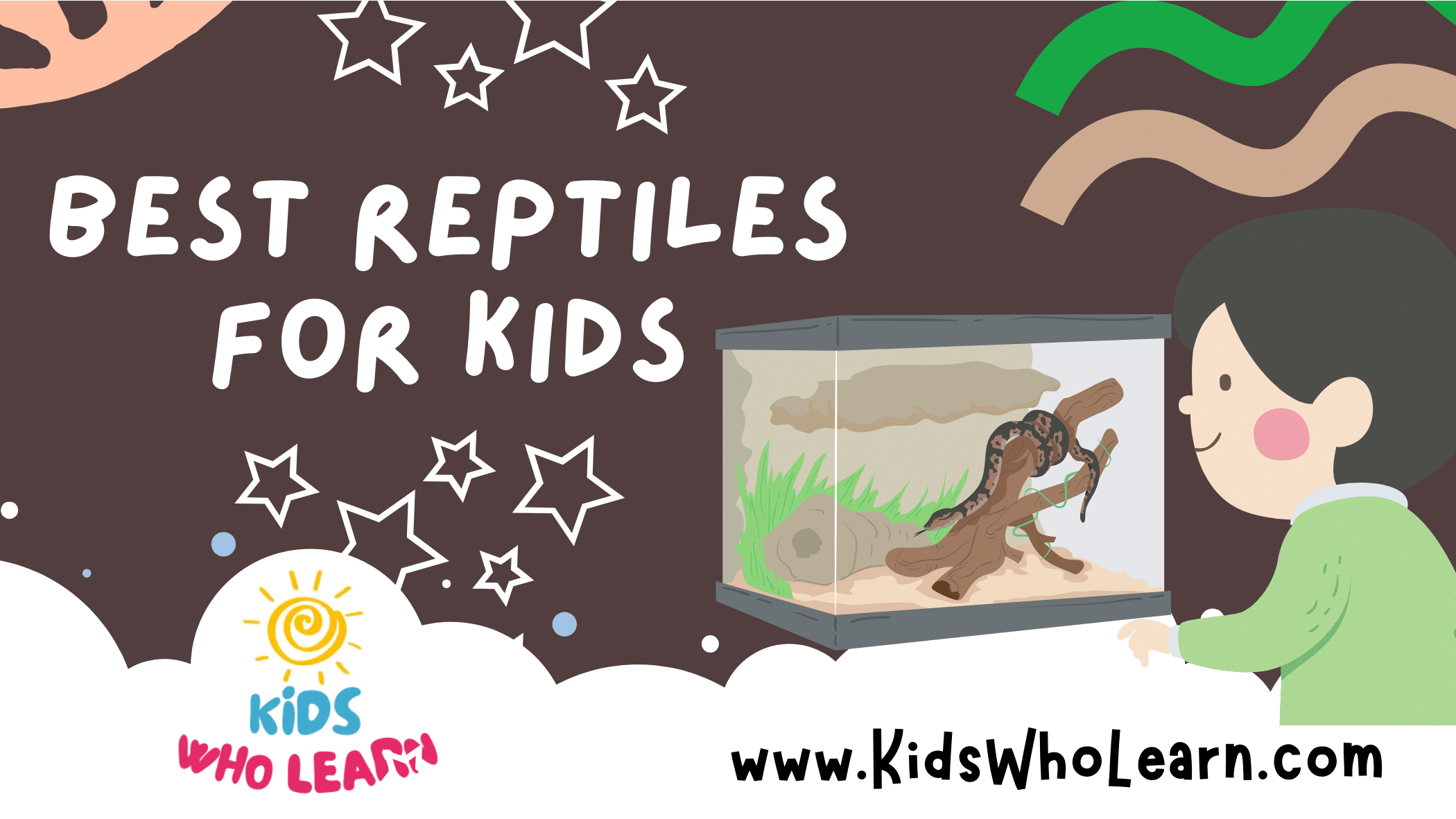When considering a pet for your child, reptiles can be a fascinating and educational choice. Unlike other pets, reptiles have specific needs and characteristics that can suit various lifestyles. They generally require less space than dogs or cats, and some species have calm demeanors suitable for children. It’s important to select a reptile that will align with your family’s ability to provide the necessary environment and care.
Bringing a reptile into your home involves more than just selecting one that your child likes; it is about understanding what kind of care and habitat the reptile will need to thrive. Certain reptiles are better suited for beginners due to their gentle nature and ease of care. Moreover, the habitat setup is critical for their health and wellbeing, so knowing how to create the perfect terrarium is essential. Reptiles can live for several years, sometimes decades, depending on the species, so it’s important to consider the long-term commitment they require.
Key Takeaways
- Certain reptiles make suitable pets for kids due to their calm nature and space efficiency.
- Proper care, including habitat setup and maintenance, is vital for the well-being of reptile pets.
- Reptile ownership is a long-term commitment pertaining to the pet’s health and lifespan.
Choosing the Right Reptile for Your Child
Selecting a reptile pet involves considering temperament, care requirements, and suitability for children. Picking the right one will ensure a positive experience for both your child and the pet.
Important Considerations
When choosing a reptile for your child, you need to assess the care requirements and whether a reptile’s temperament is appropriate for children. Reptiles like leopard geckos, Russian tortoises, and bearded dragons are known for their generally docile and non-aggressive behavior, making them suitable for families with children.
- Temperament: Ideal reptile pets for kids should be docile and non-aggressive to minimize the risk of bites or scratches.
- Care Requirements: Consider the dietary needs, habitat setup, and overall health care. Some reptiles have simple diets whereas others may have more complex nutritional needs.
Best Reptile Pets for Beginner Owners
For those new to reptilian pets, start with species that are easy to handle and maintain.
- Leopard Geckos: These reptiles are small and known for their docile temperament, making them a top choice for first-time reptile owners.
- Lifespan: 6-10 years
- Habitat: Dry, warm tank with hideouts
- Diet: Insects like crickets and mealworms
- Corn Snakes: These are a favorable option as they are non-aggressive and relatively easy to care for.
- Lifespan: Up to 20 years
- Habitat: Enclosure with a secure lid and appropriate substrate
- Diet Needs: Pre-killed or frozen-thawed rodents
- Bearded Dragons: They interact well with owners and are known for their calm nature.
- Lifespan: 10-15 years
- Habitat: Large tank with a basking area and UVB lighting
- Diet: Mix of vegetables, fruits, and insects
- Russian Tortoise: They require minimal water, making them a manageable choice for beginners.
- Lifespan: Up to 50 years
- Habitat: A large enclosure with a heat lamp
- Diet: Fresh vegetables and occasional fruits
Each of these reptiles offers a rewarding experience for kids willing to learn about their care. Perfect for children and beginner owners, these species provide an opportunity to nurture responsibility and create a bond with the natural world.
Setting Up the Perfect Habitat
When creating a habitat for a reptile, it is crucial to replicate their natural environment to ensure their health and comfort. By setting up the right terrarium with proper lighting, temperature regulation, and suitable decoration, you provide a nurturing space for your reptile companion.
Terrarium Essentials
Before you add a reptile to your family, you’ll need to choose the right enclosure and make sure it is fitted with the essentials. The terrarium is your reptile’s living space, and its size should be appropriate for the species you plan to keep. Smaller reptiles such as leopard geckos or anoles may thrive in a 10-20 gallon enclosure. Meanwhile, larger reptiles like iguanas require significantly more space.
- Substrate: This is the bedding material for the bottom of the terrarium. Options such as newspaper, reptile carpet, or coconut fiber are absorbent and easy to clean.
Reptile Type Recommended Substrate Desert Dwelling Sand, reptile carpet Tropical Dwelling Coconut fiber, bark - Decoration: Include hiding spots and climbing structures to mimic your reptile’s natural habitat. This can be tree branches, rocks, and foliage that are safe and non-toxic.
Environmental Factors
Creating the optimal conditions within the habitat is essential for your reptile’s survival and comfort.
- Lighting: Reptiles need a source of UVB light to synthesize vitamin D3, which helps them absorb calcium. An appropriate lighting system should be on for 10-12 hours a day to simulate a natural day/night cycle.
- Temperature: Each species has specific habitat requirements when it comes to temperature. Use heating lamps or under-tank heaters to create a temperature gradient where one side of the terrarium is warmer than the other.
Reptile Type Temperature Gradient Desert Dwelling 75-85°F (cool), 85-100°F (warm) Tropical Dwelling 70-80°F (cool), 80-90°F (warm) - Humidity: Similarly, humidity levels are crucial, with tropical reptiles needing higher levels than desert species. Gauge humidity using a hygrometer and adjust it through misting or a humidifier as needed.
Consistently maintaining these parameters is key to a healthy and stress-free reptile. Regular monitoring with thermometers and hygrometers will help you manage these environmental factors effectively.
Care and Maintenance
When selecting a reptile as a pet for children, understanding the specific care and maintenance needs is crucial for their health and happiness. This involves a balanced diet, a clean habitat, and regular health checks.
Feeding and Diet
Your reptile’s diet will vary depending on the species. Bearded dragons thrive on a mix of live insects like crickets and mealworms, as well as leafy vegetables such as kale and dandelion greens. For leopard geckos, stick to a diet of mainly insects. Here’s a quick reference for feeding schedules:
- Juvenile reptiles: Daily feeding
- Adult reptiles: Every other day
Remember, moderation is key to prevent obesity.
Cleaning and Hygiene
Regular cleaning is vital to keep your reptile’s environment healthy. Remove droppings and uneaten food daily. Clean the water bowl and change water regularly. Perform a thorough habitat cleaning with reptile-safe disinfectants monthly. Here’s a basic cleaning checklist:
- Daily: Spot-clean and remove waste.
- Weekly: Change substrate, if necessary.
- Monthly: Full habitat clean and disinfect.
Hand hygiene is equally important. Wash your hands thoroughly before and after handling your reptile to prevent the spread of salmonella and other bacteria.
Health and Wellness
Monitor your reptile for signs of ill health, including changes in eating habits, lethargy, or irregular shedding. A well-maintained habitat with proper temperature and humidity levels is essential for preventing health issues. Schedule regular veterinary check-ups for professional advice on your reptile’s health and wellness. Here are signs you need to watch for:
- Lack of appetite
- Visible cuts or injuries
- Mites or parasites
By adhering to these care and maintenance guidelines, you can ensure your reptile lives a long, healthy life and can be a joyous companion to your family.
Behavior and Interaction
Selecting a reptile that suits your child’s ability to engage and care for them is essential. An ideal reptile for kids should be docile to handle, require minimal but specific cleaning rituals, and offer an opportunity for interactive learning and growth.
Handling Your Reptile
When you choose a species, ensure it’s known for being docile and tolerant of handling. Bearded dragons and corn snakes are excellent examples of reptiles that usually don’t mind being held. Here’s a brief guide to handling:
- Supervision: Always supervise interactions between children and reptiles.
- Gentleness: Teach your child to handle the reptile gently, supporting their body.
- Frequency: Limit handling to a few times per week to reduce stress on the animal.
- Duration: Keep interactions short, around 5-10 minutes, especially when starting.
Social Needs
Most reptiles are not social creatures in the way mammals are, meaning they don’t require companionship from others of their kind. Understanding this helps set expectations for your child’s interaction with their pet:
- Solitary: Reptiles often prefer living alone, and housing them with others can lead to aggression.
- Observation: Encourage your child to learn by observing the reptile’s natural behaviors.
- Interaction: Interaction should be respectful of the reptile’s needs, with regular but not overly frequent handling.
Special Features of Popular Reptiles
When selecting a reptile as a pet, certain characteristics such as color variations, life span, and temperament are vital to consider for compatibility with children.
Geckos
Leopard Gecko:
- Colors: They exhibit a range of patterns and colors, from bright yellows to deep lavenders.
- Unique Characteristics: Leopard geckos have eyelids, which is unusual for geckos, and they can shed their tails as a defense mechanism.
- Lifespan: With proper care, they can live for 10-20 years.
- Easily Tamed: Recognized for their docile nature, they are easily tamed, making them excellent for young handlers.
Crested Gecko:
- Appearance: These geckos have distinctive eyelash-like crests and come in various colors and patterns.
- Unique Characteristics: They can climb smooth surfaces and have a prehensile tail to assist with grasping.
- Lifespan: Crested geckos can live for 15-20 years if cared for properly.
- Easily Tamed: They are known for being handleable and mild-tempered pets.
Snakes
Corn Snake:
- Colors: Corn snakes are known for their vivid orange and red coloration, often with black-lined patterns.
- Unique Characteristics: They have a docile nature and don’t typically grow to more than 5 feet in length, which makes them manageable for kids.
- Lifespan: Typically live around 6-8 years but can live longer with excellent care.
Ball Python:
- Colors: Offers a wide variety of morphs, ranging from natural browns to designer patterns.
- Unique Characteristics: They are known for curling into a ball when scared, hence their name.
- Lifespan: One of the longer-lived snakes, they can live up to 30 years with proper care.
- Easily Tamed: These snakes are famous for their calm demeanor and tolerance of handling, making them great for beginners.
Skinks and Tortoises
Blue-Tongued Skink:
- Appearance: They possess a distinctive blue tongue and have stout bodies with short legs.
- Unique Characteristics: Their diet is varied, including vegetables, fruits, and proteins, which can be engaging for kids to prepare.
- Lifespan: They have lifespans of 15-20 years, making them a long-term companion.
Russian Tortoise:
- Appearance: Sturdy and small, Russian tortoises feature high-domed shells and can fit in the palm of your hand when young.
- Unique Characteristics: They are known for their hardiness and ability to adapt to various environments.
- Lifespan: Russian tortoises can live for over 50 years, so they are a pet that grows with your child.
- Easily Tamed: They’re generally friendly and can be handled frequently.
Each reptile listed offers unique features which can be appealing to children, from bright and varied colors to long-term companionship. Their generally docile and tame nature makes them suitable pets for those new to reptile care.
Reptile Health and Lifespan
When selecting a reptile as a pet for your children, it’s crucial to understand health concerns specific to reptile species and the factors that influence their lifespan. Proper care, including a well-maintained habitat, is pivotal to prevent common health issues and ensure a long, healthy life for your pet reptile.
Common Health Issues
Reptiles can suffer from a variety of health issues, many of which are preventable with the correct care. Two common health problems are metabolic bone disease (MBD) and nutritional deficiencies. Metabolic bone disease is often caused by a lack of calcium or improper UVB light exposure, which is critical for reptiles to produce vitamin D3 and absorb calcium. Symptoms include lethargy, soft or deformed shells in turtles, and swollen limbs in lizards. To ensure your reptile’s health, you must provide a balanced diet rich in calcium and appropriate UVB lighting in their habitat.
| Health Issue | Symptoms | Prevention Strategies |
|---|---|---|
| Metabolic Bone Disease | Lethargy, deformities, soft shells | Adequate calcium, proper UVB lighting |
| Nutritional Deficiencies | Weight loss, poor growth | Balanced diet, species-specific supplements |
Longevity Factors
A reptile’s lifespan is significantly influenced by the level of care and environment you provide. Species such as corn snakes and leopard geckos can live for over 20 years if their needs are consistently met. These needs include proper temperature gradients, humidity levels, and a clean environment to inhabit. It is your responsibility to research the specific care requirements of your chosen species to prevent premature death and promote a full, healthy lifespan. Additionally, regular veterinary care from a vet who specializes in reptiles can help identify and treat health issues before they become life-threatening.
- Key Longevity Factors:
- Species-specific habitat requirements
- Regular preventative veterinary care
- Stress minimization through proper handling and environment
Adopting a reptile requires a commitment to understanding and meeting their health needs, which in turn influences their lifespan.
Additional Considerations
When selecting a reptile as a pet for your child, you need to consider the legal framework and long-term financial implications. Understanding these aspects ensures a responsible and ethical approach to pet ownership.
Legal and Ethical Aspects
Certain reptiles may require special permits, or may even be illegal to own in your area. It is your responsibility to check with local wildlife agencies or regulatory bodies to ensure that the pet you’re considering is lawful to have in your home. For instance, some turtle species cannot be kept legally due to conservation efforts. Moreover, ethical considerations go hand in hand with legality, as it is vital to source your pet reptile from reputable breeders to avoid supporting the illegal wildlife trade.
- Checklist for Legal Compliance and Ethical Consideration:
- Verify the legal status of the reptile species.
- Obtain necessary permits if required.
- Ensure that your pet is captive-bred from ethical sources.
Financial Commitment
Reptiles, like all pets, involve a financial commitment not just at the time of purchase but throughout their lifespan. Initial costs include the habitat set-up, which is crucial for the well-being of pet reptiles. Regular expenses will include food, which can vary widely among species, and healthcare. It’s important to note that certain reptiles have dietary needs that can be more costly than others, like those requiring a diet of live insects or fish. Non-regular costs can arise from veterinary visits or habitat upgrades as your pet grows or as needed for their health. It’s prudent to have a budget and potentially set aside an emergency fund for unforeseen expenses.
- Breakdown of Financial Commitment:
- Initial Costs:
- Habitat setup (tank, heating, lighting)
- Reptile purchase
- Ongoing Costs:
- Food
- Substrate replacement
- Utilities (heating, lighting)
- Occasional Costs:
- Veterinary care
- Habitat upgrades or repairs
- Initial Costs:
Reptile care demands a significant level of responsibility, not unlike the care required for birds, fish, or amphibians. Before deciding, ensure you are fully informed and equipped to provide the commitment needed for the well-being of these living creatures.
Life Beyond the Terrarium
When choosing reptiles as pets for children, it’s vital to consider not just the care within the terrarium but also the life lessons and companionship they can provide.
Educational Benefits
Reptiles are more than pets; they are living guides to a multitude of learning experiences. Your child’s daily observations lead to a deeper understanding of biology and ecosystems. Here’s how:
- Observation Skills: Monitoring a reptile’s behavior and habitat sharpens your child’s observation skills.
- Science Concepts: Reptiles offer real-time insight into concepts such as adaptation, thermoregulation, and the life cycle.
A structured approach to these learning opportunities can further enhance the educational value. Consider creating a logbook for your child where they track feeding times, behavior changes, growth patterns, and shed cycles of their reptile. This hands-on method encourages an analytical mindset and fosters a sense of intrigue and discovery.
Bonding and Responsibility
The care required by reptiles can establish a strong sense of responsibility in your child. Daily tasks like feeding, cleaning, and health monitoring are constant reminders of their duty to another living being. Here’s what to expect:
- Daily Care: Simple routines help your child understand the importance of regular care and the consequences of neglect.
- Long-Term Commitment: Reptiles often have lengthy lifespans, teaching kids about the long-haul commitment and the rewards it can bring.
Caring for a reptile can also forge a unique form of companionship. While reptiles might not respond like mammals, the bond formed through routine interaction is valuable. It instills empathy and a non-verbal understanding of the reptile’s needs and behaviors. Use these tips to strengthen the bond:
- Encourage gentle handling and interaction when appropriate for the species.
- Guide your child to recognize the reptile’s signs of comfort or stress to promote a caring attitude.
By integrating these elements into a child’s routine with their reptile pet, Life Beyond the Terrarium extends into life lessons that shape young minds into observant, caring, and responsible individuals.
Conclusion
When selecting a reptile pet for children, your top priorities should be safety, ease of care, and the suitability of the reptile’s temperament. Bearded dragons and leopard geckos have proven to be excellent choices due to their gentle nature and manageable size.
- Leopard gecko: docile, easy-handling
- Bearded dragon: friendly, likes interaction
Ensure you have all the necessary equipment and understand the care requirements for your chosen reptile. This includes understanding their habitat, diet, and healthcare needs.
| Reptile | Life Span | Diet | Size | Temperament |
|---|---|---|---|---|
| Bearded Dragon | 10-15 years | Omnivorous (Insects and Vegetables) | Medium | Gentle and Friendly |
| Leopard Gecko | 6-10 years | Insectivorous (Mainly Insects) | Small to Medium | Docile and Calm |
Remember to think long-term, as reptiles can be a commitment for several years. With the proper care, a reptile can be a fascinating and rewarding pet for children, offering an educational experience into the care of exotic animals. Always purchase pets from reputable sources to ensure they are healthy and have been treated well.
Frequently Asked Questions
In this section, you’ll find concise answers to common questions about beginner-friendly reptiles and those suitable for both home and classroom settings.
Which reptiles are recommended for beginners and easy to care for?
Beginners should consider the Leopard Gecko as they are docile and require minimal space. Another excellent starter reptile is the Bearded Dragon, thanks to its agreeable temperament.
What is an ideal reptile for a classroom environment?
Corn snakes make an ideal reptile for classroom environments due to their calm nature and ease of handling. Russian Tortoises are also suitable because they are resilient and can be interactive.
Which lizards are known for being particularly good with handling?
Bearded Dragons are famous for their tolerance to handling and interaction with humans. Crested Geckos also exhibit good temperaments and are less likely to be stressed by regular handling.
What are the safest reptile pets for children?
For safety, choose reptiles like Leopard Geckos and Corn Snakes, which are known for their docile behavior and minimal risk of biting when handled properly.
Are there any beginner-friendly gecko species suitable for kids?
The Leopard Gecko and the Crested Gecko are among the most kid-friendly species, as they have simple care requirements and a gentle disposition.
What types of snakes are considered kid-friendly and low-maintenance?
The Corn Snake and the King Snake are considered both kid-friendly and low-maintenance, making them ideal first snakes for young enthusiasts. They require basic enclosure setups and are generally not aggressive.















